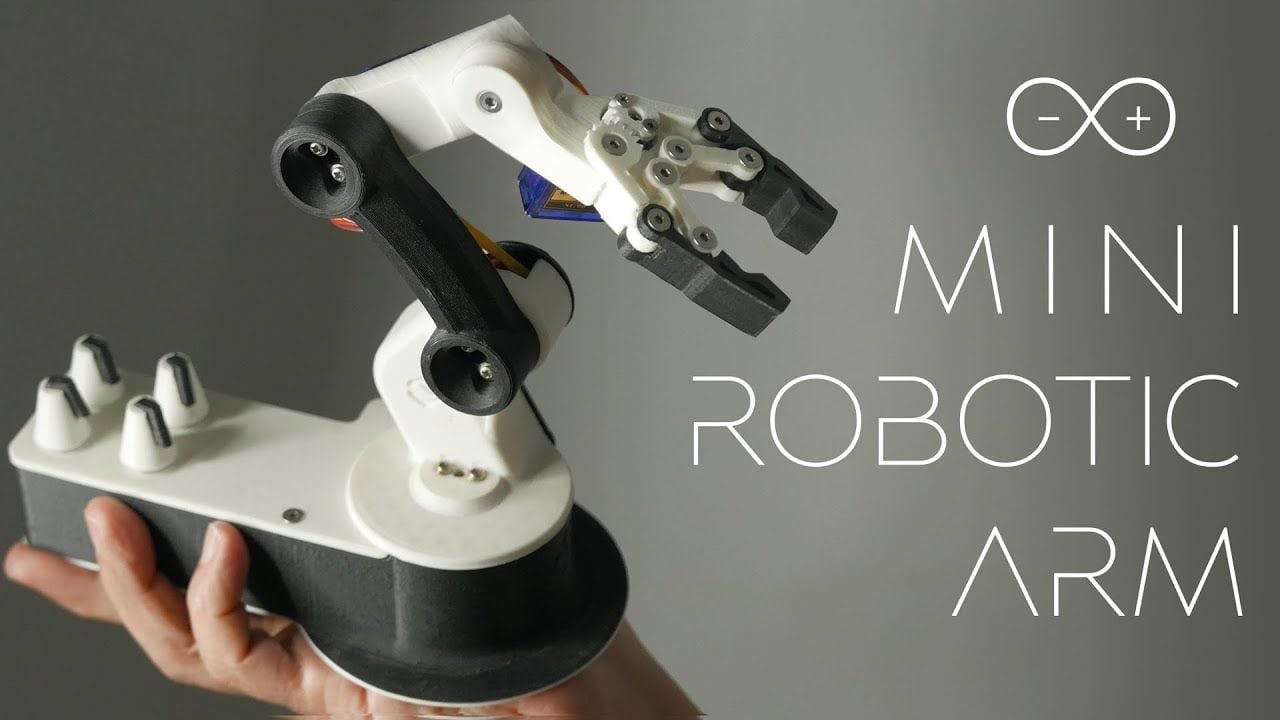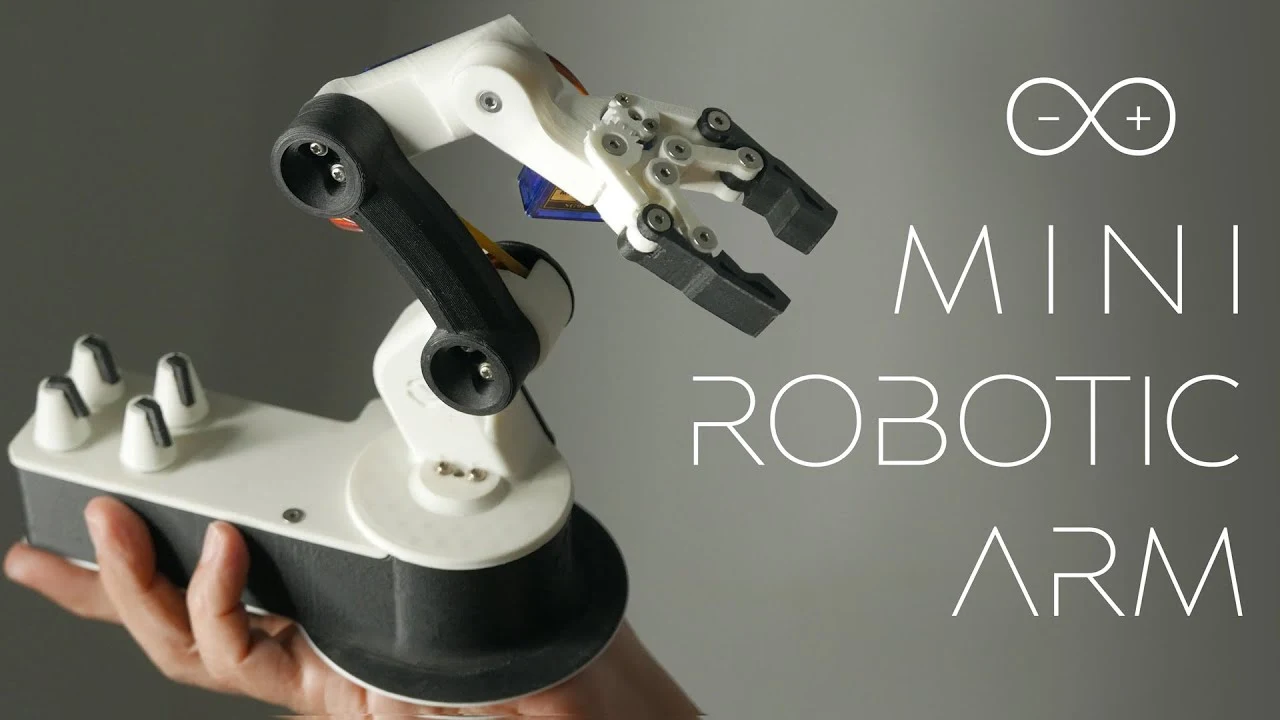
[ad_1]

Tired of watching cool robotics projects online and feeling like they’re out of your reach? You’re not alone. Many enthusiasts face the challenge of turning their tech dreams into reality. But what if there was a way to bridge that gap? This robot arm guide offers a guide to building a mini robotic arm using Arduino, complete with 3D-printed parts and easy-to-follow instructions. By the end, you’ll not only have a functioning robotic arm but also a newfound confidence in your DIY skills.
Prepare to dive into an exhilarating project that seamlessly merges creativity and technical prowess as you embark on the journey of creating your very own mini robotic arm using Arduino and 3D printing technology. This guide will be your companion throughout the entire process, guiding you through each step, from the initial design and printing of parts to the final assembly and programming of the arm for both manual and automated control.
The Heart of the Project: Key Components and Overview
At the core of this captivating project lie the 3D-printed parts and electronic components that harmoniously come together to give life to your functional robotic arm. You will harness the power of potentiometers to control the arm’s movements with precision, allowing you to save and replay sequences, thus enhancing the arm’s versatility and adaptability to various tasks.
- 3D-printed parts: Designed using Fusion 360 and printed with black and white PLA filament
- Electronic components: Arduino Nano, servomotors, potentiometers, resistors, capacitors, and more
- Control system: Breadboard and custom PCB for organized connections and smooth operation
Electrical Setup and Assembly
Begin your journey by carefully organizing the electronic connections using a breadboard and a custom printed circuit board (PCB). With a steady hand and keen attention to detail, solder the essential components, such as resistors, capacitors, headers, push buttons, and a DC power jack connector, onto the PCB. These elements will form the sturdy backbone of your control system, ensuring reliable performance throughout the arm’s operation.
Next, introduce the Arduino Nano, the brain behind your robotic arm, to the setup. Connect it securely and upload the carefully crafted code that will breathe life into the servomotors, allowing them to respond to your commands with precision and grace.
DIY Arduino Mini Robotic Arm
Here are a selection of other articles from our extensive library of content you may find of interest on the subject of humanoid robots :
Bringing Your Vision to Life: 3D Design and Printing
Unleash your creativity as you design the robotic arm using the powerful Fusion 360 software. This robust tool allows you to craft every intricate detail of your arm, ensuring that it meets your specific requirements and aesthetic preferences. Once your design is complete, download the files and prepare to witness your vision materialize through the wonders of 3D printing.
Using high-quality black and white PLA filament, print the carefully designed parts that will form the structure of your robotic arm. The design has been carefully optimized to minimize the need for supports during the printing process, resulting in a more efficient and waste-free experience.
Assembling the Masterpiece: Mechanical Assembly
With your 3D-printed robot arm parts and electronic components ready, it’s time to embark on the mechanical assembly of your mini robotic arm. Use the reliable SG90 or MG90S servomotors and a variety of screws to construct the arm, forearm, and claw mechanism with precision and care.
As you progress through the detailed assembly instructions, pay close attention to cable management. Ensuring that the cables are neatly organized and tucked away will not only enhance the arm’s aesthetic appeal but also guarantee smooth and unhindered operation.
Bringing Your Creation to Life: Operation and Functionality
Experience the joy of controlling your mini robotic arm manually through the intuitive potentiometers, each linked to a servomotor. This setup allows for precise and nuanced movement control, empowering you to manipulate the arm with finesse and accuracy.
But the capabilities of your creation don’t stop there. The arm also features an automatic mode, allowing you to record and replay movement sequences with ease. This feature opens up a world of possibilities, allowing you to automate repetitive tasks or create intricate motion patterns.
To ensure that your robotic arm performs consistently and reliably, power it using a 5 Volt, 3-amp adapter or a PC power supply. This stable power source will provide the necessary energy for the arm to function at its best, without any interruptions or fluctuations.
The Final Touches: Setup and Testing
As you approach the final stages of your robot arm project, it’s time to complete the last assembly steps and put your mini robotic arm to the test. Take a moment to familiarize yourself with the control modes and button functions, ensuring that you can effectively save and replay movements with confidence.
This final stage is crucial in ensuring that your robotic arm operates smoothly and meets your expectations. Take the time to fine-tune any adjustments and marvel at the culmination of your hard work and dedication.
- Test manual control: Use potentiometers to manipulate the arm’s movements with precision
- Experiment with automatic mode: Record and replay movement sequences for automated tasks
- Fine-tune and adjust: Make any necessary adjustments to ensure optimal performance
By following this guide, you will successfully create a mini robotic arm that showcases the incredible potential of Arduino technology and 3D printing. This project serves as a testament to your growing technical skills and provides a solid foundation for further exploration in the captivating world of DIY robotics.
Embrace the challenges, revel in the successes, and let your imagination soar as you bring your mini robotic arm to life. The possibilities are endless, and the satisfaction of creating something truly remarkable with your own hands is an experience like no other.
Media Credit: FABRI creator
Filed Under: DIY Projects, Guides
Latest Geeky Gadgets Deals
Disclosure: Some of our articles include affiliate links. If you buy something through one of these links, Geeky Gadgets may earn an affiliate commission. Learn about our Disclosure Policy.
[ad_2]